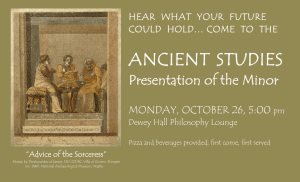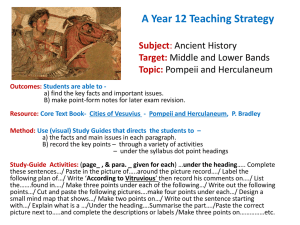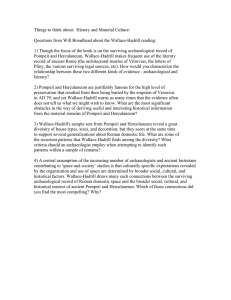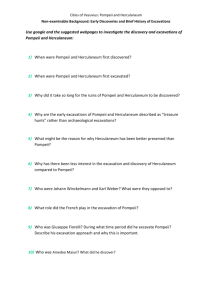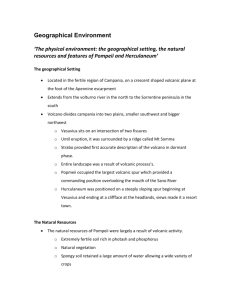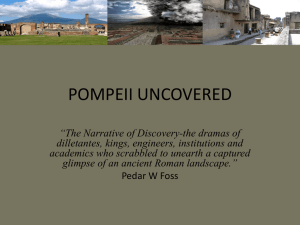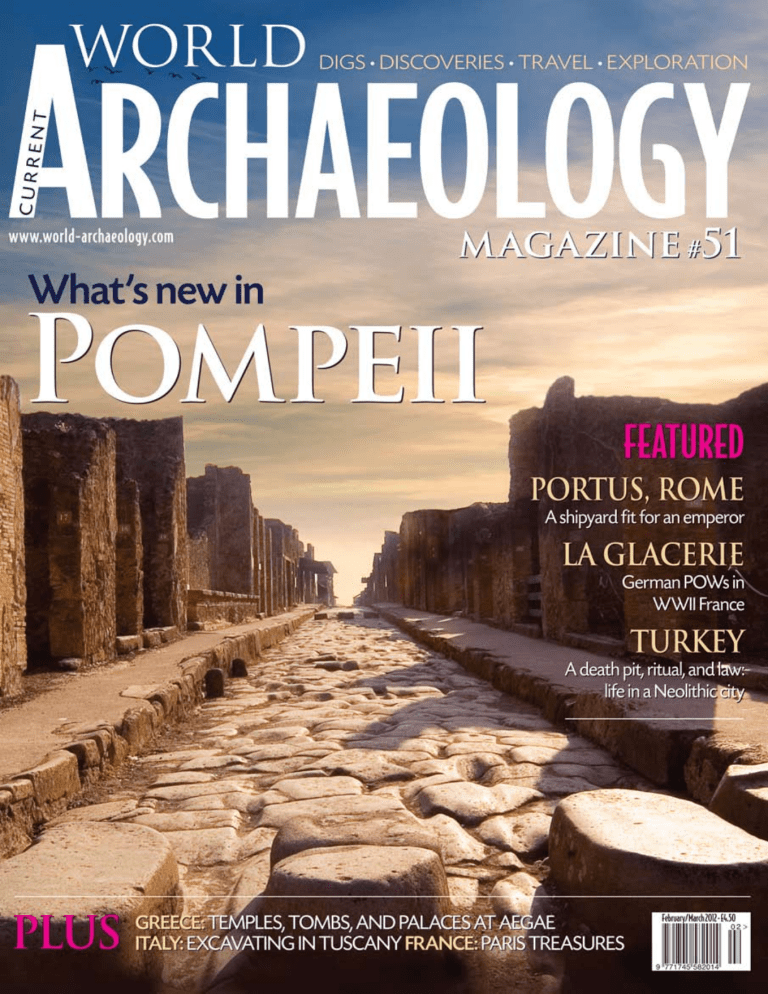
IT A LY Rome ▲Pompeii Sardinia NAPLES Tyrrhenian Sea Sicily Ionian Sea Pompeii ▲ still giving up its secrets Excavations at Pompeii began in 1748. Today, advances in technology are being used to preserve and conserve. And, as Joanne Berry and Sarah Court reveal, the ancient city still has much to tell us. So, what is new in Pompeii? P ompeii and its neighbour Herculaneum are among the oldest archaeological sites in the world, but today they risk destruction by exposure to the elements, tourist traffic, and time. Yet these are not new problems. As early as the 18th century, excavators applied varnish to wall-paintings in an attempt to prevent their decay; different types of conservation work have taken place on site ever since. However, the collapse of part of the Schola Armaturarum in 2010, and subsequent minor collapses, have highlighted the problem 18 CurrentWorldArchaeology to the world and today it has become a politically important issue. The challenge now is to ensure the preservation of these sites while continuing investigations into the town, its inhabitants, and its history. How can we preserve Pompeii’s past for our future? And what more is there to learn? Large-scale open-air excavations at Pompeii came to an end in the 1960s because the authorities recognised that further excavation would only make the conservation problem worse. But at the same time, funding cuts and other management problems meant that day- Above The fountain in front of Regio I, Insula 9, looking east on the Via dell'Abbondanza. This is one of the many that supplied water throughout the city. below A view of Mount Vesuvius looking across the forum from Via delle Scuole. Issue 51 PHOTOS: Jennifer Stephens / Jennifer & Arthur Stephens / Rebecca Benefiel italy to-day maintenance halted. Conservation took place in the best decorated houses, but elsewhere on site was conducted on an emergency basis. Consequently the conservation problem worsens each year. Now, as the EU steps in with a conservation grant of €105 million, the hope is that Pompeii’s decay will be slowed. In the meantime, scholars continue their work at Pompeii and at other nearby sites, but, partly in reaction to the conservation crisis and to site-management issues, the way that they study these sites has changed. In the 1990s teams were given an excavated insula (housing block) to study its evolution through stratigraphic excavation beneath the AD 79 floor levels, its architectural development through examination of its walls and paintings, and its contents through study of the original excavation reports and inventories. As a result our understanding of Pompeii’s development as a Roman city has increased: it is no longer seen as a ‘city frozen in time’, but as a settlement with a long and interesting history before its destruction by Vesuvius in AD 79 (see box below right). Most of the research carried out at Pompeii today is smaller in scale, informed by conservation and with the explicit aim of studying and recording as much as possible before it disappears forever. While stratigraphic excavations beneath the AD 79 levels are possible, many teams now adopt non-invasive methods of study. The result is that the aims and results of these projects are more varied than those of the past, and reflect on a wider range of aspects of the city’s life. Scratching the surface During 250 years of excavation at Pompeii, about 44ha of ruins (including 20,000m2 of wall paintings) have been uncovered, and more than 11,000 painted or incised inscriptions found. Rebecca Benefiel, of Washington and Lee University, is documenting the graffiti scratched on the fragile plaster walls before they disappear. www.world-archaeology.com above Photomosaic of the Via dell’Abbondanza, Regio IX, Insula 7. right Rebecca Benefiel measures a sample of ancient graffiti. Damage to the original surface means some graffiti, like this drawing of a man's head, are visible only under certain lighting conditions. Previously studied as stand-alone texts, her innovative approach examines their spatial and social context. She has shown that graffiti tend to cluster in visible and highly trafficked areas of houses, and was clearly an accepted social activity rather than a furtive and anonymous act of vandalism. And everyone was at it: male and female, slaves and the free. Messages may be informative, comic, or even enigmatic: the House of Maius Castricius bears the cryptic statement: venimus huc cupidi multo magis ire cupimus se[t] retinet nostros illa puella pedes – we came here desiring. [Now] we desire much more to go, but that girl holds back our feet. Concern with creating a record of the site before it decays further is shared with Jennifer and Arthur Stephens, who set up the Via dell’Abbondanza Project in 2004. The Via dell’Abbondanza, lined with some of the best preserved buildings in Pompeii, runs from the forum in the west of the city to the Sarno Gate in the east, close to the amphitheatre. They used state-of-the-art equipment to create photomosaics of its entire 900m length that record the current condition of its facades. When the street was partially excavated between 1911 and 1923, photography was being used for the first time to document the work. Often, workmen and supervisors were included in these scenes. These photomosaics provide a stark yet hauntingly beautiful contrast to such earlier studies, and will form an invaluable digital archive for scholars studying the ancient street and conservators aiming to preserve it. Digital revolution Photography and computer reconstruction of images is playing an a brief history of pompeii Pompeii may have been founded by local Oscans, but from an early period both Greeks and Etruscans took an interest in its development, undoubtedly because of its prime location on the Bay of Naples. The Greek-influenced Doric Temple dates to the 6th century BC, and Etruscan pottery was found in its foundations. By the end of the 5th century the town had been conquered by the Samnites, but by the 2nd century it was already heavily influenced by Rome, in terms of both political structure and public buildings. In 80 BC it was one of the Italian towns that opposed Rome during the Social War, and as a result was stormed by Sulla. Pompeii became a Roman colony, the Colonia Cornelia Veneria Pompeianorum, and Sulla settled many of his veteran soldiers there. The town prospered during the 1st century AD, until it was flattened by an earthquake in AD 62. Repairs were still underway in AD 79 when Vesuvius erupted. CurrentWorldA rchaeology 19 PHOTO: Jennifer Stephens above Looking north on Via Stabiana from the crossroads with Via dell’Abbondanza. The large stepping stones enabled pedestrians to cross without having to step down into the street. important part in the Oplontis Project, at the Villa of Poppaea, a couple of miles outside Pompeii. The international multidisciplinary team, led by John R Clarke and Michael L Thomas of the University of Texas at Austin has created a fully navigable 3D model and reconstruction of the villa. Archival photographs from the villa’s initial excavation and reconstruction in below The University of Bologna's Vesuviana Project is using digital technology to examine and create virtual reconstructions of the buildings. middle & right The use of iPads and other technology is helping speed up the excavation process, disseminating information as soon as it is recorded. 20 CurrentWorldArchaeology the period from 1964-1984 have proved essential for the Oplontis Project’s reconstruction, but they have also brought home with terrible clarity how severe the deterioration of the villa’s wall-paintings has been over the last decades. The project has found a positive use for these photos, however, using them to reconstruct paintings for the digital reconstruction. Clarke believes that ‘with every year that passes, valuable evidence disappears. Our careful and systematic work in the villa will document this endangered resource’. Their model will not only be the first completely accurate record of the actual state of the villa, it will also digitally preserve this monument for future generations. Many Italian universities are active in the Vesuvian area. The University of Bologna’s Vesuviana Project is a multiple-strand research project for Pompeii and Herculaneum. At Pompeii, its focus is the Insula of the Centenary (IX.8) – first excavated in 1879, exactly 1,800 years after it was destroyed by Vesuvius. The insula has been studied not just by archaeologists and art historians, but by geologists, structural engineers, chemists, IT specialists, and conservators. Their use of archival material – usually drawn illustrations – to find out exactly what was revealed in the original excavations, and which is then combined with information from new surveys and virtual reconstructions, has been the key, like the Oplontis Project, to integrating a range of evidence to further our understanding of Roman houses. High-tech equipment is a frequent sight at Pompeii these days, not least because it speeds up the recording process and allows data to be more easily manipulated. In 2010, the Pompeii Archaeological Research Project: Porta Stabia (PARP:PS), based at the University of Cincinnati, went completely digital in their excavations. For the first time iPads were used to complete all the usual form-filling related to a dig, as well as all the technical drawings, stratigraphic diagrams, and excavation notebooks. Not only was information gathered more quickly, but it could be distributed almost immediately among the experts working on the project instead of awaiting costly post-excavation digitisation. And at the same time, the project has funded the reconstruction of many failing walls in the area of its excavations – another sign of the commitment that today’s archaeologists have towards the conservation of Pompeii. Issue 51 the Schola Armaturarum The Schola Armaturarum (erroneously known as the House of the Gladiators) was mostly excavated in 1915 by Vittorio Spinnazzola who was intrigued by the painted depictions of weapons and armour that framed the wide entrance to the building. Since then there have been many theories about its use – a school, a storeroom, a depository of gladiatorial weapons, none of which are supported by the finds made during excavation. Today few of the stunning wall-paintings remain. Many were lost when the building was hit by an Allied bomb in 1943, one of over 150 dropped accidentally on Pompeii during the Second World War. The Schola Armaturarum was restored in the 1950s and given a reinforced concrete roof, but this did not prevent the destruction of the remaining paintings. On 6 November 2010 heavy rains caused the collapse of part of the building, and led to media hysteria around the world. Funding cuts were blamed, and the Soprintendenza was accused of apathy – an unfair accusation given the small number of technical staff and the huge problem of conservation. Restoration of the building is again under way. ABOVE Photomosaic of Regio III, Insula 3, before (RIGHT) the collapse of the Schola Armaturarum. Cold cases Much of the new work now taking place at Pompeii involves re-examining previously excavated material. Estelle Lazer undertook the first modern systematic study of the human skeletal remains of the victims from Pompeii. When she started, the skeletons were stored in ancient buildings, which they shared with different kinds of wildlife, and had become disarticulated over time. Excavated during the preceding centuries, the intrinsic value of human www.world-archaeology.com skeletons as an archaeological resource had never been recognised. But even compromised archaeological material can yield valuable results: using modern forensic techniques and statistical studies, Lazer has overturned the long accepted assumption that the people who did not manage to escape the wrath of Vesuvius were the old, the infirm, the very young, and women. The skeletal remains, in fact, show that the victims reflect a random sample of a normally distributed population. Perhaps the most iconic images from Pompeii are the casts of the forms of the victims. Past interpretations have been based on visual examination and circumstantial evidence, which means that they owe more to storytelling than science. But Lazer has obtained permission from the Soprintendenza to scientifically study the casts with X-ray and other medical imaging techniques. This non-invasive work will be done in situ to ensure that the fragile casts are not damaged, and will provide solid information about the actual lives and deaths of these victims. Beyond the walls Exciting archaeological discoveries are not limited to the Vesuvian towns: the entire Campanian area was densely settled, its fertile soil cultivated by farmers. In 2006 a group of German and Italian institutions, headed by the German Archaeological Institute (DAI Berlin), began to explore the Sarno River plain that surrounds Pompeii, Stabiae, and Nuceria. Nearly 2,000 core samples were taken to ascertain the entire area’s topography and geology before the AD 79 eruption. Data on more than 150 Roman farms is shedding light on agricultural production, land divisions, and the ancient road network. But perhaps the project’s most important contribution has been to draw attention to this neglected, yet significant, heritage before it is lost. Sometimes conservation and excavation has the greatest impact when the local below left Estelle Lazer X-rays the casts to collect new data on Pompeii’s dead. Middle Body cast of a man, located in the storeroom on the west side of the forum. right Body casts in the Garden of the Fugitives. CurrentWorldA rchaeology 21 Illustration: Programma Vesuviana PHOTOS: PARP:PS / Estelle Lazer / Jennifer Stephens PHOTO: Jennifer & Arthur Stephens italy PHOTOS: Dr Florien Seiler / Jennifer Stephens above Examining wood samples: the Sarno-Becken Project is shedding new light on the use of wood, forest ecosystems, and climatic conditions in the area in the period leading up to the AD 79 eruption, as well as providing accurate chronological data. below These photos show the Pollena Trocchia site at the start of excavations in 2007, when it was still filled with rubbish, and after the most recent excavation campaign in 2011. A villa and bathhouse are slowly emerging from the modern debris. 22 CurrentWorldArchaeology Archaeological Heritage Prize for its work with the local community, and has generated enough interest to ensure that the site is protected. ‘The key has been to involve the people of the neighbouring building, who literally guard the site throughout the year,’ says De Simone. The initiative has shown that the north slope of Vesuvius was re-inhabited soon after the eruption of AD 79. More importantly, the excavation of this large villa and bath has united the people of the area in their pride for their local heritage. Pompeii’s future Sadly, most reports on Pompeii these days focus on the negative: collapsed buildings, lack of funding, the prospect of theme park-style reconstructions to accommodate the two million plus visitors. But this, as we have seen, is not above The view north across Pompeii towards Vesuvius, with the Garden of the Fugitives in the foreground on the right. an accurate picture. There is still much to learn from the Vesuvian area. The range of current initiatives illustrates the enormous energy of archaeologists who are actively contributing to the recording of these unique sites and coming up with challenging new theories. Nor is all hope lost for preservation. Just down the road, the Herculaneum Conservation Project (see box opposite) demonstrates how a planned and comprehensive approach to conservation can have a dramatic impact on the preservation of an archaeological site, while also improving our knowledge. It is all far from doom and gloom under the shadow of Vesuvius. Issue 51 PHOTOS: Girolamo Ferdinando De Simone community is involved. In 1998 the remains of a villa were found on public land at Masseria de Carolis in Pollena Trocchia on the north slope of Vesuvius, next to a construction site. The construction company was owned by the camorra (the local mafia). It had been using volcanic debris from the villa to mix mortar, and later tried to destroy the site. Fortunately, the authorities found out and put a stop to it. Even so, after a brief study the site was abandoned and became an illegal rubbish dump. As lead archaeologist Girolamo Ferdinando De Simone explains, ‘When we arrived at the site, it couldn’t be seen. The small fence around it was half torn down and inside it there was a washing machine, some tyres, and even a Christmas tree. The rest of the site was literally covered by trash.’ The Apolline Project has been excavating here since 2007. In 2011 it won the European italy authorities have to deal with, and a serious problem at Pompeii. At Herculaneum, this is tackled by draining all the water on site down to the ancient shoreline and then out to sea. In advance of such works on the ancient beach level, the HCP’s archaeologists cleared and studied the area, discovering that in a pre-Roman phase the natural bedrock of tuff had been quarried to provide building materials for the construction of the city above. In addition, a remaining section of the original Roman beach of black volcanic sand was found. But the most unexpected – and unique – discovery occurred at the foot of the House of the Telephus Relief, where the house’s original timber roof was found four floors below its original position (CWA 42). It had been swept off the house by the force of the eruption. Not only had all the different parts of the roof survived – some carbonised though most waterlogged – but pigments were found on the ceiling panels n the last 10 years many lessons have been restoring 20th-century reinforced revealing an elaborate decorative scheme. learned by archaeologists and conservation concrete lintels, and consolidating wall A test trench was excavated below the specialists working at Herculaneum that paintings and bubbling mosaics. water table beside this building when a new Managing both the rain and ground could also be applied to Pompeii. roof was planned to replace the original water on an archaeological site is one The last major archaeological campaigns and it revealed that the foundations were of the most important issues that the at Herculaneum were the excavations a previously unknown extra floor of of the ancient shoreline in the the building. It transpired that the 1980s, when over 300 skeletons below The collapsed roof from the House of the Telephus Relief – the original roof had fallen through four floors. Romans themselves had filled it in were uncovered, and the work in and buried it in the hope of protecting the 1990s on a corner of the Villa this seafront property from the of the Papyri. However, these encroaching sea. projects coincided with the worst Archaeological research on the moment in Herculaneum’s recent ancient shoreline showed that, in the history when a failure to maintain period before the AD 79 eruption, the already excavated areas of Herculaneum was seriously affected the ancient city resulted in two by bradyseism – a phenomenon that thirds of the site being closed to occurs in seismic areas, where the the public as buildings and their earth’s surface rises and lowers, and decorations crumbled. which is particularly visible in coastal Since 2001, thanks to the longtowns as the sea appears to retreat and term commitment of the Packard encroach. Humanities Institute, working The Surburban Baths illustrate the together with the Soprintendenza problems clearly: the building had and the British School at Rome, been repaired in places as its tuff blocks emphasis has been placed on were eroded by the action of the sea, conservation. A decade of work by and many of the large windows that the Herculaneum Conservation brought light into it had to be partially Project (HCP) has not solved every blocked in the same period to prevent problem, but all the Roman streets the sea from entering. have been reopened to the public Recent works around the Villa of and a range of buildings have been the Papyri by the Soprintendenza made safe by re-establishing a aimed to return this archaeological water drainage network, replacing area to a manageable state. To date collapsing modern roofing, Herculaneum is leading the way PHOTOS: Sosandra/HCP /Andrew Selkirk / I www.world-archaeology.com CurrentWorldA rchaeology 23 PHOTOS: Andrew Selkirk / Brian Donovan/HCP ILLUSTRATION: Aldo Cinque/HCP italy FURTHER INFORMATION above Diagram showing the fluctuating sea levels along the coastal edge of Herculaneum. source Joanne Berry, Swansea University, j.t.berry@swansea.ac.uk Sarah Court, Herculaneum Conservation Project, s.court@herculaneum.org. only part of the Villa has been exposed. As most of it lies beneath the modern town centre of Ercolano, it is unlikely to ever be completely excavated. But the recent works demonstrate how much can be learned from the areas that have been uncovered. A room on a lower level of the Villa, one corner of which had been explored previously, was more fully excavated, revealing its extraordinary stucco decorations. Archaeologists have shown how the room was being redecorated at the time of the eruption. Some stucco panels had been prepared by the decorators but not completed and the last brushstroke can be seen on an uncompleted border. The work undertaken by the HCP and the SANP has not just preserved the material remains of the past for future research, but has generated a whole series of archaeological results that arguably would never have emerged without the focus given by the conservation priorities. The richness of the Vesuvian sites means 24 CurrentWorldArchaeology that work even in previously excavated areas or insignificant corners never fails to turn up new results that change the way we think about Roman life. below The stunning stucco artwork in the Villa of the Papyri, at Herculaneum, was in the process of being redecorated when it was destroyed by the volcanic eruption of AD 79. Apolline Project: www.apollineproject.org/ Herculaneum Conservation Project: www.herculaneum.org Oplontis Project: www.oplontisproject.org/ Pompeii Archaeological Research Project: Porta Stabia: classics.uc.edu/pompeii/ Sarno-Becken Project: www.dainst.org/de/ node/23679?ft=all, www.salve-research.org Vesuviana Project: www.vesuviana.info/, www.pompeiisites.org/ Via dell’Abbondanza Project: www.pompeii perspectives.org/ SANP: www.pompeiisites.org For up-to-date news and discussion: www. bloggingpompeii.blogspot.com Acknowledgments: We would like to thank Regina Gee, John R Clarke, Jennifer and Arthur Stephens, Estelle Lazer, Steven Ellis, Pia Kastenmeier, Girolamo Ferdinando De Simone, Antonella Coralini, and Rebecca Benefiel. Thanks are due to the Soprintendenza Speciale per i Beni Archeologici di Napoli e Pompeii for use of images of its sites. Issue 51
